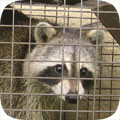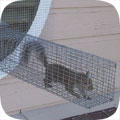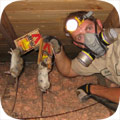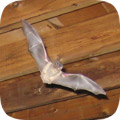- suffolk@wildlifeanimalcontrol.com
Call 24/7 for a free quote:
757-777-9824
Suffolk Wildlife Animal Control
Professional Wildlife Removal Company Servicing Suffolk, VA
If you have a problem with wildlife in your Suffolk home, your best option is to hire a company that specializes in Virginia wildlife removal only. This is a specialty business, and regular pest control companies do not use the proper techniques to solve animal problems. I have spent many years reviewing Virginia and Suffolk, and I recommend the following:
Professional Wildlife Services
Cell Phone: 757-777-9824
NOTE: If you have a dog or cat problem, call Nansemond County Animal Services: (757) 514-7855

Professional Wildlife Services specializes primarily in removing animals from attics of homes and buildings - this includes squirrels in attics, raccoons, and rats or mice in homes. Virginia also has a documented problem with
bats in buildings, and Professional Wildlife Services is specially trained in bat removal. They also perform general wildlife trapping services, such as the capture and removal of skunks or opossums on the
property. Call 757-777-9824 to discuss your critter problem and schedule a same-day or next-day appointment. Click here to learn more about
what prices we charge in 2025.
When hiring a company to solve your wild animal problem, you want these features:
- Specializes in wildlife removal, not pest control
- Fully Virginia and Nansemond County licensed and insured
- Works 7 days per week (critters don't take weekends off)
- Performs full building inspections: enters and inspects attic
- Performs exclusion repairs, with guarantee against animal re-entry
- Offers cleanup of biohazardous wildlife waste
Professional Wildlife Services is a full-service Suffolk wildlife removal company. This is very different from a regular Suffolk pest control company. The pest control companies spray poison to kill insects. This is not at all
similar to wildlife removal. Professional Wildlife Services performs a full inspection of the home or property, and determines why the animal(s) are there, and if inside a building, how the animals got inside. All
animals (including rodents) are trapped and removed, or if possible, removed from the building using special exclusion devices. Once the animals are gone, preventative repairs are essential, and
cleanup is sometimes recommended.
 Suffolk wildlife trapping - it's not as simple as it may seem. It's illegal in Virginia to trap without a license. Trap type is very important and there are many different types, bait is somewhat relevant, trap placement
is vital, and there are dozens of small things that are very important to know.
Safety is a concern. Then once the animal is trapped, it must be removed and dealt with in the proper manner according to Virginia law. We offer Suffolk raccoon removal. Read more about how to get rid of raccoons.
Suffolk wildlife trapping - it's not as simple as it may seem. It's illegal in Virginia to trap without a license. Trap type is very important and there are many different types, bait is somewhat relevant, trap placement
is vital, and there are dozens of small things that are very important to know.
Safety is a concern. Then once the animal is trapped, it must be removed and dealt with in the proper manner according to Virginia law. We offer Suffolk raccoon removal. Read more about how to get rid of raccoons.
 Animals in attics - this is our specialty at Professional Wildlife Services. Many types of animals like to live in attics. This includes squirrels, raccoons, rats, mice, bats, birds, and even possums. Critters like to go into attics for a safe place to live
and raise their young. Removing animals from attics is very complex work, partly because of the presence of baby animals. If you need Suffolk squirrel removal, we can remove all the squirrels from your attic, and seal out any future ones. Read more about how to get rid of squirrels.
Animals in attics - this is our specialty at Professional Wildlife Services. Many types of animals like to live in attics. This includes squirrels, raccoons, rats, mice, bats, birds, and even possums. Critters like to go into attics for a safe place to live
and raise their young. Removing animals from attics is very complex work, partly because of the presence of baby animals. If you need Suffolk squirrel removal, we can remove all the squirrels from your attic, and seal out any future ones. Read more about how to get rid of squirrels.
 Rodent control must be done in a very specific way. First off, the most important thing is that all the openings that rats and mice can use to enter a house be sealed. Then all the rodents must be physically trapped and removed.
Never, ever use poison! Most Suffolk exterminators will just use this lazy poison technique to kill rodents, and it causes more harm than good - dead stinky rats, and it doesn't solve the problem. Call us for correct Suffolk rat removal. Read more about how to get rid of rats.
Rodent control must be done in a very specific way. First off, the most important thing is that all the openings that rats and mice can use to enter a house be sealed. Then all the rodents must be physically trapped and removed.
Never, ever use poison! Most Suffolk exterminators will just use this lazy poison technique to kill rodents, and it causes more harm than good - dead stinky rats, and it doesn't solve the problem. Call us for correct Suffolk rat removal. Read more about how to get rid of rats.
 Bat removal is a highly specialized task. Virginia is known to have colonizing bats who often live in buildings. Bats love attics. If not removed, the colony can grow to a very large size over the years. The bat droppings are often corrosive and
cause health risks. The same goes for bird droppings on or in buildings. We perform Suffolk pigeon removal and bird control. But our specialty is Suffolk bat removal. We remove 100% of the bat colony and seal the building so that it's totally bat-proof. Read more about how to get rid of bats.
Bat removal is a highly specialized task. Virginia is known to have colonizing bats who often live in buildings. Bats love attics. If not removed, the colony can grow to a very large size over the years. The bat droppings are often corrosive and
cause health risks. The same goes for bird droppings on or in buildings. We perform Suffolk pigeon removal and bird control. But our specialty is Suffolk bat removal. We remove 100% of the bat colony and seal the building so that it's totally bat-proof. Read more about how to get rid of bats.
 If you have animals inside a house, no job is complete without proper exclusion repairs. If you simply hire a Suffolk trapper who only removes the critters, then the problem will return. You need to hire a Suffolk wildlife control company that identifies 100% of the animal entry points
into your building, and seals them shut with professional repairs. In addition, in many cases animals have left waste or contamination behind, and you'll want a company that can provide professional cleaning services. Professional Wildlife Services does both.
If you have animals inside a house, no job is complete without proper exclusion repairs. If you simply hire a Suffolk trapper who only removes the critters, then the problem will return. You need to hire a Suffolk wildlife control company that identifies 100% of the animal entry points
into your building, and seals them shut with professional repairs. In addition, in many cases animals have left waste or contamination behind, and you'll want a company that can provide professional cleaning services. Professional Wildlife Services does both.
The above are just some of the services offered by Professional Wildlife Services. We also trap and remove animals that destroy lawns, such as moles, or digging animals. Sometimes animals like opossums will live under buildings, steal pet food, raid garbage cans, etc.
Read about how to get rid of opossums. Skunks commonly live under sheds or decks, and set up a den. We can trap and remove them without them spraying. Read about how to get rid of skunks. Professional Wildlife Services
also provides dead animal removal in Suffolk. If you need help with any other wildlife conflict, from a fox, beaver, groundhog, or any other critter, we can solve it. We also do Suffolk snake removal - most of the snakes in Virginia are not venomous, but
call us if you want safe removal, or read about how to get rid of snakes in Suffolk. And remember, we are a private business, not Nansemond County Animal Control Services, so if you have a dog or cat problem, call the County at (757) 514-7855.
Nansemond County animal services does not handle any wildlife issues.
Professional Wildlife Services
Cell Phone: 757-777-9824
Suffolk Pricing Info
Every wildlife removal situation is different, from the species of animals involved, the location of the animal inside a house or outside, the extent of repairs or cleanup, etc. It's impossible to give one-size-fits-all prices. Examples MIGHT include:Small Job: For example, a one-stop job to remove an animal in the yard: $100 on up
Medium Job: For example, getting critters out of your house with minor repairs: $300 on up
Large Job: For example, a project involving many service trips and complex work: $500 on up
Give us a phone call now and tell us about your wildlife issue and we will be able to give you a price estimate over the phone. If you're cool with it, we can schedule a same-day or next-day appointment if you like. Our prices are fair, and a good value because we do the job right, the first time.
Suffolk Wildlife Tip #1:
The Coral Snake: Appearance, biology, life cycle, habitat, diet, behavior
The coral snake is one of the most easily distinguishable species of snakes on the planet. Although there are 16 different species of coral snakes, all have very similar circular bands around them that make the snake extremely unique in appearance.
The coral snakes that are found in North America are distinguishable by a series of bands that are red, white or yellow, and black. There are other snakes that have different colors to their bands, yet still look similar to the coral snake. What usually separates them is the fact that the similar looking snakes don't have a yellow band them, but still have the red and black.
The snake ranges from about 3 feet to 5 feet in length, with the largest being close to 6 feet that is ever been reported. They have a flattened tail, which enables them to be able to swim, much like a fin.
These snakes are pretty unusual in the fact that they spend the vast majority of their time buried under leaves or other materials that are found on the floor of the forest area. They usually only come to the surface for three purposes. The first of these is to avoid the heavy rains, the second is during breeding season, and the third is to hunt. Otherwise, they are quite content in living beneath the leaves and other foliage that falls to the floor of the forest area.
Because of their venom, the coral snake is able to feed on such things as other snakes, frogs, lizards, birds, and small rodents. They have a pair of small hollow fangs, which release the venom once they have sunk their teeth into their potential prey. These fangs are positioned in the front of the snake's mouth, allowing them to have a strong grip once they have sunk their teeth into potential prey.
While falling into the class of venomous snakes, the coral snake is not an aggressive reptile in comparison to other species fall into this category. In fact, less than 1 percent of the number of snakebites that occur in this country each year are related to coral snakes. This shows how truly content these animals are just simply be left alone.
The average coral snake can live up to about five years in the wild. The lifespan expands to about seven years in captivity.
Coral snakes are most often found in the southernmost portion of the US. This includes such areas as North Carolina, Louisiana, and Florida. They are usually found in areas where there are pine or oak trees, trees that offer great protection from the leaves and pine needles that they drop to the surface below them.
While these are not extremely aggressive snakes, it should be noted that coral snakes are some of the most potent reptiles on earth. Should they bite a person a few times, the amount of venom can be fatal, meaning that you should avoid these animals at all cost, and seek medical attention immediately should you be bitten.
Suffolk Wildlife Tip #2:
Virginia Wildlife Information:
Virginia State bird: Northern cardinal
State mammal: Virginia big-eared bat
State fish: Brook trout, striped bass
State insect: Tiger swallowtail butterfly
Virginia is attached to the Chesapeake Bay, and because of this, it has a large coastal plain that extends inland, passing the bay's tributaries and eventually ending at the swelling of rocky foothills. Those foothills spread into the Blue Ridge Mountains, an extension of the Appalachian range. The state has an abundance of carbonated rock which has led to the creation of thousands of cave systems. Ten of those systems are currently open to the public, leaving about 3,990 on private land or currently uncharted. Along with the caves comes a variety of bat species, including the big brown bat, Brazilian free-tailed bat, eastern red bat, evening bat, gray bat, and the hoary bat, to name a few. Caves are the perfect habitat for these animals, which can either migrate or hibernate in the colder months. While Virginia is not prone to particularly harsh winters, the cave systems make a good, temperature-controlled place for hibernation.
Bats, though numerous, are only a small portion of the animal population in Virginia. The state has a number of predators including black bears, bobcats, cougars, and coyotes. This state doesn't have huge issues with the larger predators mainly because of how mountainous and wild the habitat has remained. The coastal plain is much more covered in people's homes, and this is where critters like squirrels and raccoons love to play. Because of the amount of trees in this state, it doesn't take long for a vertical-loving animal to find a way into a house. While raccoons and squirrels are definitely on the list of nuisance animals, they are among a score of others including woodchucks, skunks, porcupines, and opossums.
The state is also perfect for birds, and Virginia has a population of golden eagles, a large avian that tends to live in isolated settings across the globe. Not much research has been done on the golden eagle, and Virginia wildlife authorities hope they can study the growing population and shed some light on the species.
The fresh water feeding into the Chesapeake Bay provides a good ecosystem for amphibians and reptiles, and Virginia has a number of water-loving snakes including the cottonmouth and the common water snake. The state also has glass lizards, a snake-like creature, and the only limbless lizard in the United States.
You can always call Professional Wildlife Services, any time of day, at 757-777-9824, for a price quote for Suffolk wildlife control services. I am confident that this is the best choice amongst wildlife removal companies in Suffolk, VA.







































